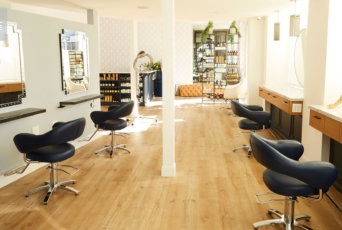When Tara Foley first became concerned with wellness, she focused on the “obvious” things: food, exercise, mindfulness. She did yoga every day, cooked for herself, and ran triathlons. But before long, another aspect of wellness — one that wasn’t getting any attention at the time — began to capture her attention. As she became more aware of the harmful ingredients in conventional skincare products, and the lack of any conversation around it, she realized that there was a huge hole in the non-toxic skincare space. She made it her mission to fill that hole, and ultimately became founder and CEO of Follain, one of the first clean beauty brands.
*This is a short clip from our interview with Tara Foley. Click here to watch the whole thing!*
You can also listen to an audio version of our interview with Tara Foley on The WellBe Podcast.
Looking for Non-Toxic Skincare — And Finding Nothing
When Foley graduated from college, she moved to New York City for a job that she ended up hating. In a new city and unhappy with her work, she didn’t know what to do, and so she began really focusing on her own health and wellness for the very first time. Self-care was the only thing that was working for her, the only thing that felt good, and so it became central to her life.
She started cooking for herself, learning about nutrition, practicing yoga, and training for races. Before long, Foley’s wellness focus began to extend beyond just fitness and nutrition and into the world of beauty and skincare. After all, if she believed it was important to move her body in certain ways, and to be mindful of what she put in her body, shouldn’t it also matter what she put on her body (especially since the skin is our largest organ)? She began to skim the ingredient lists of products she’d been using her whole life, and was shocked to see that almost all of them contained pretty harmful ingredients. “Harmful for people, harmful for the planet, harmful in every capacity,” she remembers.
Fresh out of college with a degree in public policy and an activist spirit, Foley became passionate about the toxic ingredients she’d discovered lurking in everyday products. She began writing a blog on the topic, and it consumed her.
Foley told her friends and family members about what she was learning and asked them all if they’d ever turned over their skincare or beauty products to read the ingredients and think about what was in them. Everybody said no. “This was 2008, and the conversation about non-toxic skincare hadn’t really started,” Foley says. She became “really fired up” over the fact that nobody was talking about this, and so she decided to spark that conversation.
The beauty industry, she knew, was incredibly lucrative, and big beauty had created a set of beliefs and values that perpetuated demand for conventional beauty products. “What the big beauty industry is doing is saying, ‘You need to look a certain way, and, by the way, you need to use all of these toxic, awful ingredients to get there,’” Foley says. She saw this as incredibly disrespectful to women, and knew that companies would continue to create a demand for products that contained cheap, harmful ingredients that didn’t even really do anything — unless someone stepped in to make the industry change.
There had been no changes to regulations or policy with regard to ingredients in skincare or beauty products since 1938 (Yup. Almost EIGHTY YEARS!), so Foley knew that it would take a business, rather than lobbying, to implement any change. And that set her on the path of creating a clean beauty brand that prioritized non-toxic skincare.
For curated recommendations on non-toxic beauty and skincare products, plus thousands of other items across 20+ different categories, check out the WellBe Non-Toxic Products Database.
How the Non-Toxic Skincare Movement Has Changed In the Past Decade
Since Foley’s first days of reading ingredient lists in 2008, she’s seen the movement and conversation around clean makeup and skincare change immensely. When she first became interested in non-toxic skincare, there were almost no clean beauty brands out there trying to make a change. By the time she opened the first Follain store in 2013, there were only 10 companies they trusted enough to sell (Follain both manufactures their own non-toxic skincare and sources products from other vetted clean beauty brands).
Since then, things have changed. Foley has watched as consumers have become more and more passionate and educated about non-toxic skincare, and have subsequently begun to demand better choices. This, in turn, has compelled some big beauty companies to start cleaning up their act a bit, and creating lines and products that are better for people and for the planet (though there’s still a long way to go). She also points out that it’s led to the development of more “green chemistry,” or innovation that allows for more effective, clean ingredients in products.
Today, Foley says, there seems to be a new clean beauty line launching every day, but it wasn’t always this way. She’s watched in amazement as the non-toxic skincare and makeup space has totally transformed over the years, and praises the people who helped make that happen. “It was truly because of these informed women and mothers,” she says. “They were basically pounding their fists and saying, ‘No, we deserve better.’ We’re in a much better spot now.”
The Three Most Toxic Ingredients in Conventional Beauty Products
If you look at the ingredients in any conventional beauty product, you’ll see a list that just goes on and on and on. A lot of the things in common items are harmful — either to your body, the planet, or both — but some are worse than others. According to Foley, these are the three worst offenders found in skincare and beauty products that people use every day:
1. Fragrance
Foley emphasizes the fact that there’s a total lack of regulation in the beauty industry in the U.S., and there’s no better illustration of this than the “fragrance” loophole. According to law, “fragrance” is considered a trade secret, so companies don’t have to disclose what, exactly, goes into a certain fragrance. That means that when you see the word on an ingredient list, it could be hiding up to 10,000 different ingredients — and you have no way of knowing what they are. These can include petroleum-based ingredients, which are incredibly harmful for the environment, as well as carcinogens, which are incredibly harmful for you. Note that you might also see the word parfum in ingredient lists — this is just “fragrance” in French.
2. Parabens
Parabens are used as a preservative in many beauty and skincare products, and despite their ubiquity, they can have serious negative consequences for your health: namely, endocrine disruption, aka hormone disruption. Hormone disruption is a major problem, because when the balance of hormones in your body is off, it can lead to a whole host of issues, from PCOS to fibrocystic breasts. Additionally, hormones are intimately connected to gut health, which is huge (as Foley put it, “gut health is the foundation of all human health as we know it”). Hormone disruption can also lead to developmental issues and birth defects, which is why a lot of products are off-limits for pregnant and breastfeeding women (and, like, if something is damaging to a developing human, shouldn’t it be a red flag to us fully-developed humans as well??).
Foley explains that there are many different kinds of parabens, with six or seven different classes and multiple parabens within each class, and that some are far more harmful than others. However, as she says, “if you can avoid them, just avoid all of them.” Which is totally possible, since Foley told us that there are tons of safe preservatives that work just as well.
3. Sodium Laureth Sulfate (SLS)
Foley explains that this common ingredient is popular because of a brilliant, decades-old marketing campaign that convinced everyone that cleansing products (soap, body wash, shampoo, you name it) needed to create lots of foam and suds in order to get you clean. This campaign worked incredibly well, and created a massive demand for SLS, which is what causes products to foam. Foley told us that not only are suds and foam unnecessary to get yourself clean, they are also drying and potentially irritating to your skin.
How to Find Clean Beauty Brands You Can Trust
Given what the research says about the harmful ingredients in conventional products, making the decision to transition to non-toxic skincare and trade your conventional makeup for clean beauty brands is a no-brainer. But it’s also easier said than done.
When Foley first started out, the problem was that there weren’t a lot of non-toxic skincare brands out there. Today, there’s the opposite problem: there are an overwhelming amount of “clean” brands out there, but how do you know who is really selling you products that have been fully vetted, and who just has good branding?
Foley’s number one tip for determining whether something is truly “clean” or just has good branding is to look at the ingredient list. The shorter the better — sometimes, just one ingredient is all it takes! “It’s the same thing as food,” Foley says. “If you read an ingredient list, it should be fairly short and fairly recognizable, right? I just think that instead of looking for ingredients to avoid, I would find brands and products and ingredients that you know you trust and that you know work well for your body specifically and just stick with them.”
And Foley emphasizes the fact that these natural ingredients really work. “That’s the only reason why our business is growing and why this piece of the industry is growing,” she says. “Because it actually works.”
Replacing conventional products with non-toxic products is a big project. The WellBe Spark Health Program guides you through it step-by-step, helping you get rid of toxins and harmful ingredients in every aspect of your home and life, from beauty and skincare to home essentials to food to medicine and beyond.
The WellBe Takeaway on Non-toxic Skincare and Clean Beauty
Foley shared a lot of incredible insight about non-toxic skincare and why it matters, but all of this information can be a little scary, and a lot overwhelming. We’ve broken it down into a few key points to remember:
- Conventional beauty and skincare products are generally filled with all sorts of ingredients that are harmful to both your body and the environment.
- Policy and regulation around beauty and skincare has remained stagnant for going on 80 years, so businesses like Follain have emerged to meet the increasing demand for non-toxic skincare and clean makeup.
- The most toxic things to look for on the ingredient lists of your skincare and makeup products are fragrance (or parfum), parabens (which come under many different names, but normally end in -methyl or -ethyl), and sodium laureth sulfate.
- When looking for non-toxic skincare products or clean beauty brands, look for things with minimal, familiar ingredients, and talk with an expert to find the right thing for you (not everything will work for everyone, just like food!).
- Remember that perfect is the enemy of done. So don’t wait until you have the time to do a full audit of all of your products and make a complete switch to non-toxic skincare and clean makeup brands. If you’re too busy to do it all at once, just make the choice to replace conventional products with clean beauty products when they run out. Any change is better than no change (and if you want help doing it all, consider the WellBe Spark Health Program)!
Switching to non-toxic skincare can seem like a big challenge, but it’s totally worth it. As Foley said, “you deserve to use products that are healthy for you and healthy for the planet, and that actually make you confident and make you glow.”
Watch our full interview with Tara Foley to hear about what she thinks clean brands can learn from Estée Lauder, the one product that she recommends those just getting started with clean beauty swap out first, why makeup is just like food, what’s happening in terms of clean beauty policy and regulations, her personal beauty routine, and much more.
You can also listen to an audio version of our interview with Tara Foley on The WellBe Podcast.
Have you made the switch to non-toxic skincare and clean makeup brands? Whether the answer is yes or no, tell us your story in the comments below!
The information contained in this article comes from our interview with Tara Foley. Foley is the CEO and founder of Follain and holds an MBA from Babson College, and a B.A. from Trinity College. She is a board member of the Natural and Organic Health and Beauty Alliance.
Citations:
- Panico, A et al. “Skin safety and health prevention: an overview of chemicals in cosmetic products.” Journal of preventive medicine and hygiene vol. 60,1 E50-E57. 29 Mar. 2019, doi:10.15167/2421-4248/jpmh2019.60.1.1080
- Lam C, Patel P. Food, Drug, and Cosmetic Act. [Updated 2023 Jul 31]. In: StatPearls [Internet]. Treasure Island (FL): StatPearls Publishing; 2024 Jan-. Available from: https://www.ncbi.nlm.nih.gov/books/NBK585046/
- Liang, Jiefeng et al. “Studying paraben-induced estrogen receptor- and steroid hormone-related endocrine disruption effects via multi-level approaches.” The Science of the total environment vol. 869 (2023): 161793. doi:10.1016/j.scitotenv.2023.161793
- Branco, Nara et al. “Long-term repetitive sodium lauryl sulfate-induced irritation of the skin: an in vivo study.” Contact dermatitis vol. 53,5 (2005): 278-84. doi:10.1111/j.0105-1873.2005.00703.x








COMMENTS